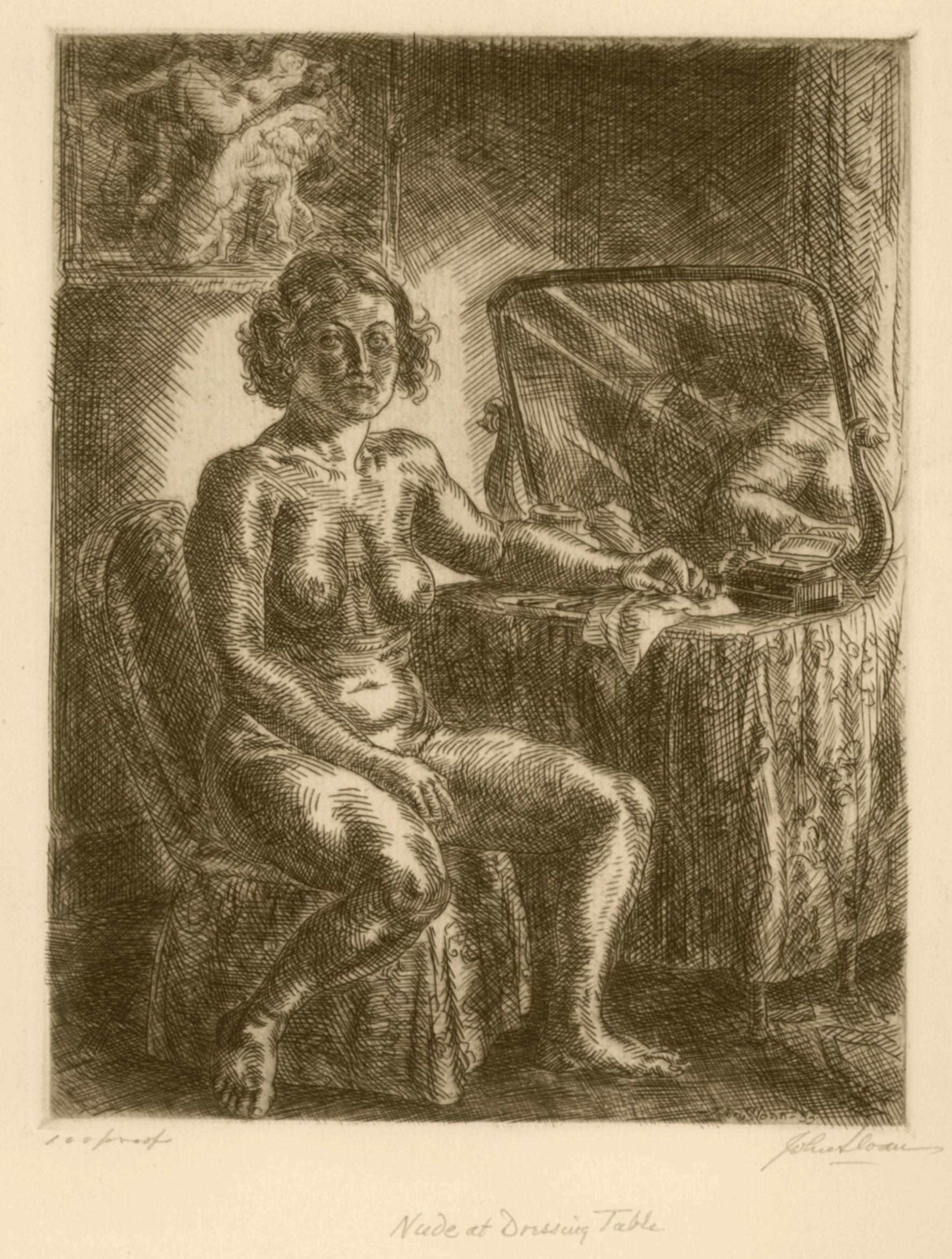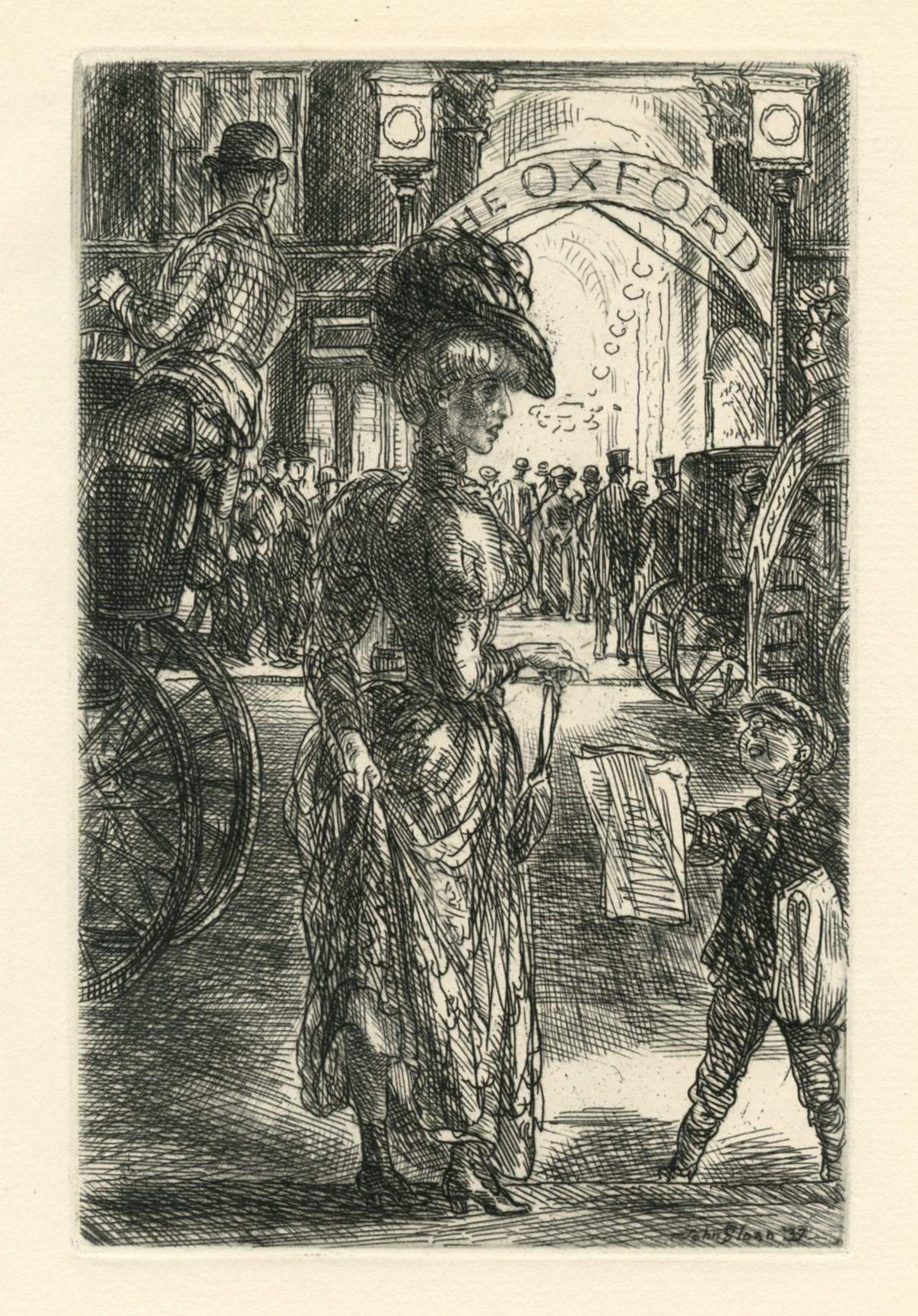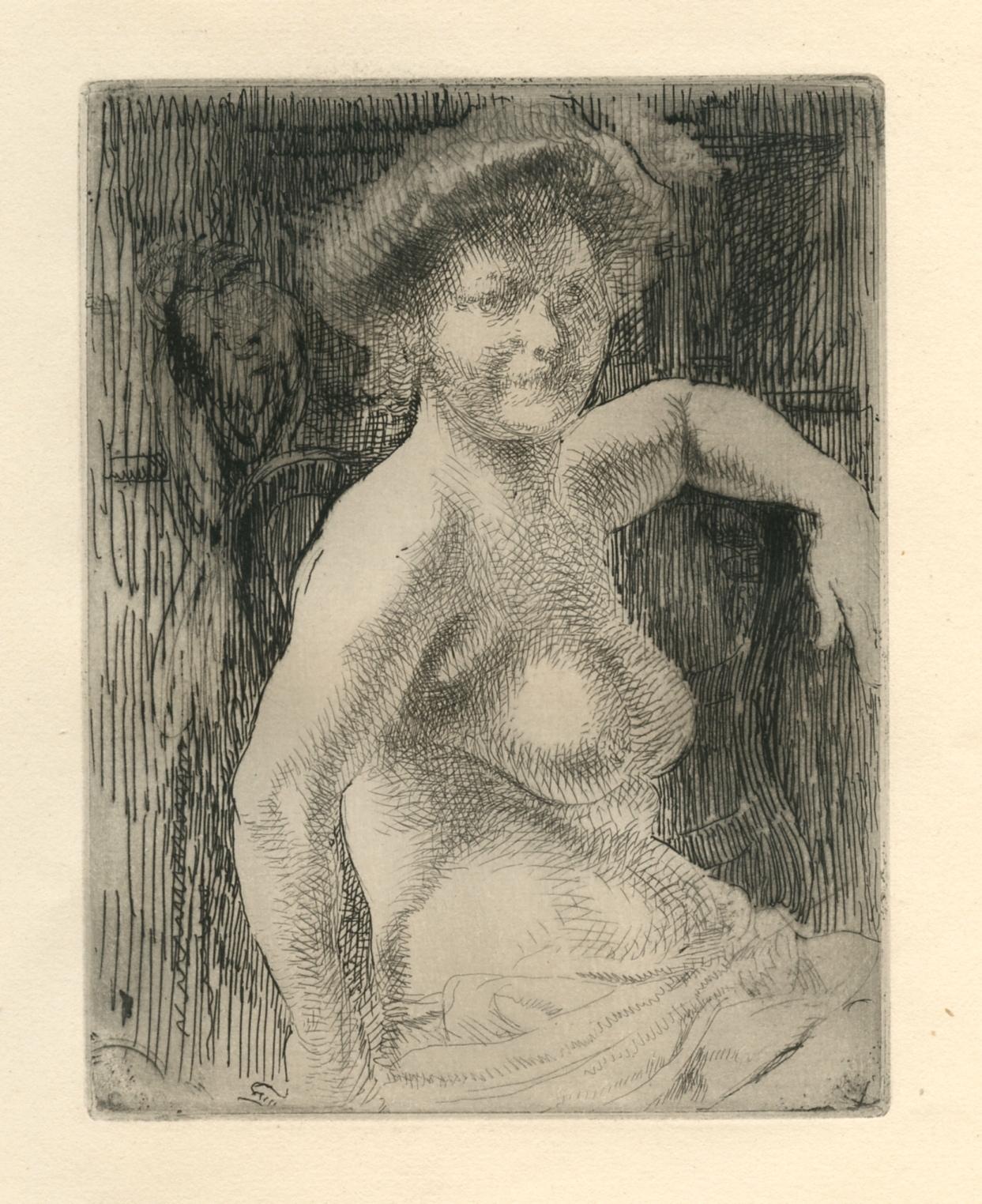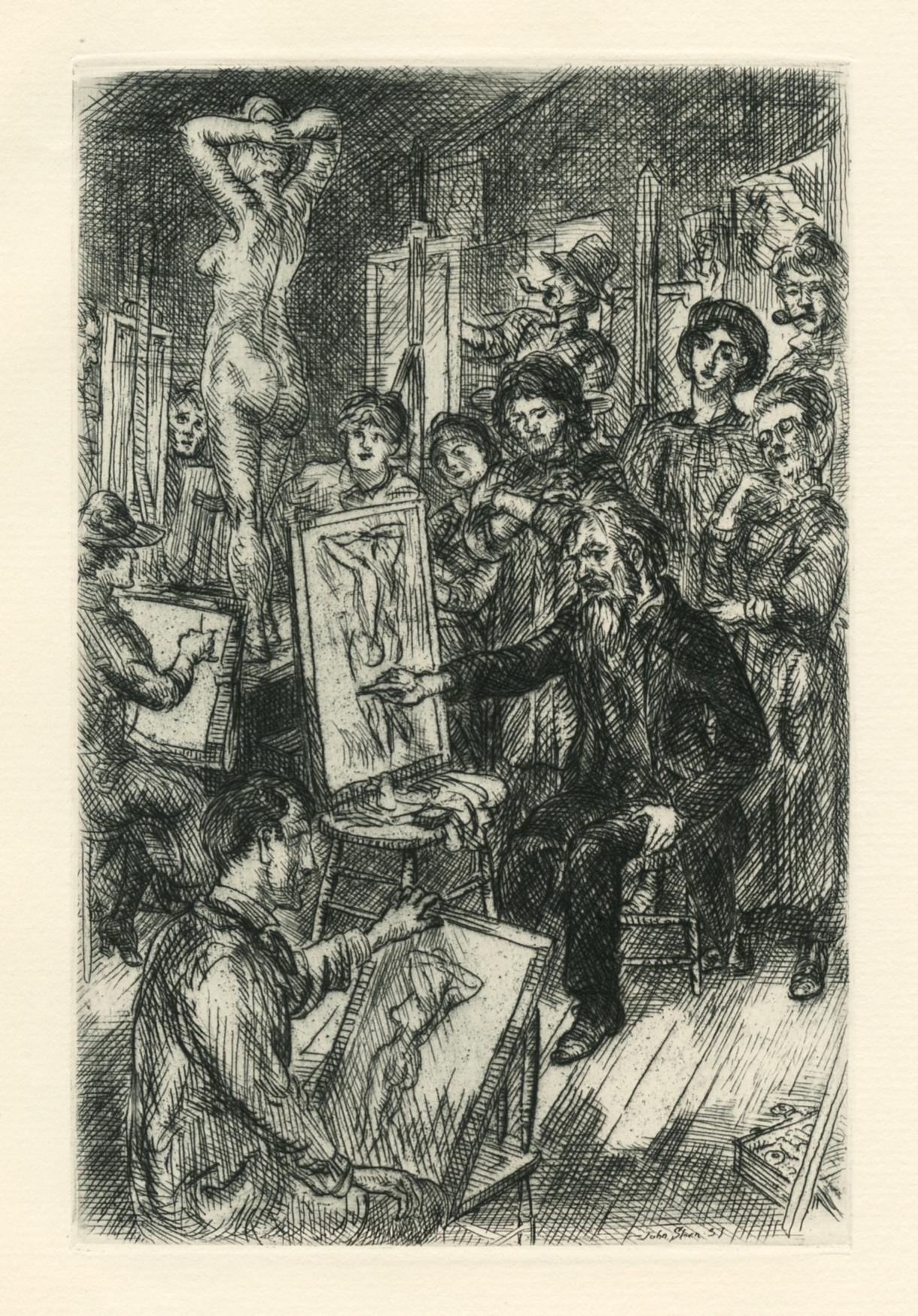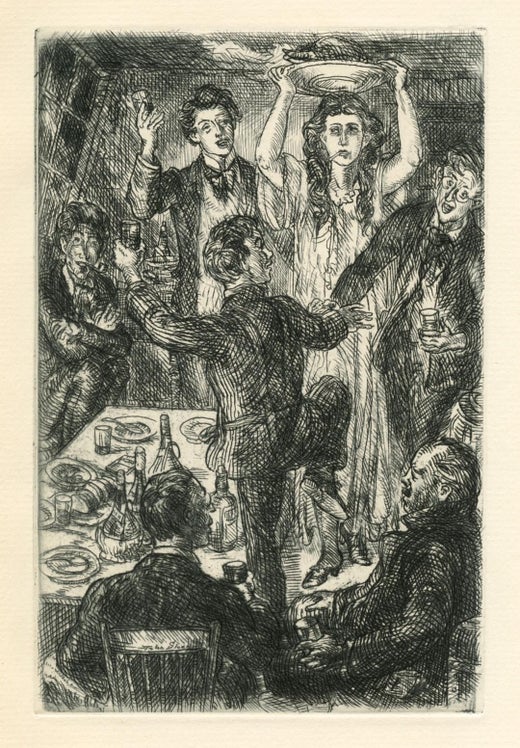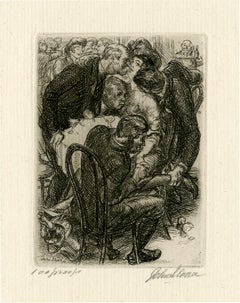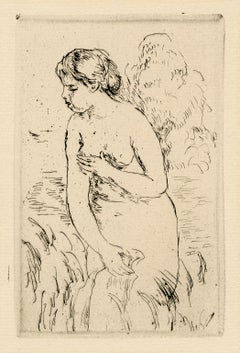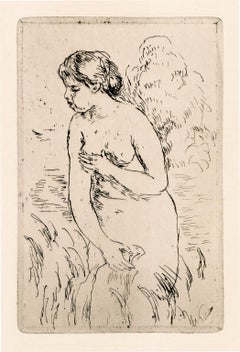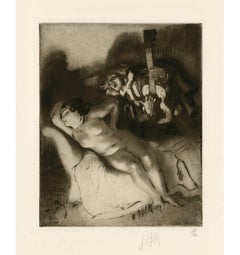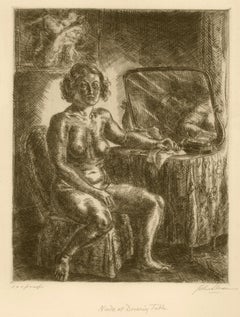Want more images or videos?
Request additional images or videos from the seller
1 of 3
John SloanNude at Piano1933
1933
$1,600
£1,206.56
€1,395.44
CA$2,244.79
A$2,495.23
CHF 1,307.94
MX$30,472.74
NOK 16,328.92
SEK 15,362.47
DKK 10,415.18
About the Item
John Sloan, 'Nude at Piano', 1933, etching, edition 100, (only 85 printed), Morse 265. Signed, titled and annotated '100 proofs' in pencil. Signed and dated in the plate, lower right. A fine, richly inked impression, in warm black ink, on cream wove paper, with full margins (1 1/2 to 4 inches). Slight toning at the sheet edges, otherwise in good condition.
“A strong relationship between this etching and the painting of Renoir is to me quite noticeable. My own best results in painting of the nude are made with the same graphic intent” –John Sloan, from the catalogue Raisonné 'John Sloan's Prints', Peter Morse, Yale University Press, 1969.
Impressions of this work are in the permanent collections of the following institutions: Delaware Art Museum, Detroit Institute of Arts Museum, Library of Congress, Metropolitan Museum of Art.
ABOUT THE ARTIST
Dubbed the “dean of American artists,” John Sloan was one of the most influential members of the Ashcan School. Born in 1871 in Lock Haven, PA, he lived and worked in Philadelphia for most of his early career. Self-taught in etching, he additionally attended night classes at the Spring Garden Institute and enrolled at the Pennsylvania Academy of Fine Arts between 1892-1894, where he studied under Thomas Anshutz. Sloan began his career in commercial illustration in 1892 working for the Philadelphia Inquirer; later moving to the art department at the Philadelphia Press. A member of the ‘Philadelphia Five’, he frequently met with William Glackens, George Luks, Everett Shinn, and Robert Henri at Henri's studio. Henri had a profound influence on Sloan and encouraged him to pursue a fine art career. Sloan moved to New York City in 1904, then the nation’s cultural and intellectual center and the home of a flourishing art scene. He quickly came to love New York and described it as the “gayest of cities, the cosmopolitan palette where the spectrum changed in every side of the street.” Sloan’s subjects, as diverse and varied as the city itself, celebrated the lives of ordinary Americans in a way that was unprecedented in American art. He painted and etched New York’s great avenues and landmarks, the tenements of the Lower East Side, the sweeping vistas of the Manhattan skyline, the crowd of working-class men at McSorley’s Bar, the audience in the moving picture house, the election night festivities in Herald Square, and the trio of women drying their hair on a Sunday morning. Sloan’s images of New York provided a sprawling and comprehensive pictorial testament to urban life and culture. His student, Guy Péne du Bois aptly described him as the “historian of Sixth Avenue, Fourteenth Street, Union Square, and Madison Square.” Sloan was keenly aware of New York’s rapidly changing environment and acknowledged that “the fun of being a New York painter is that landmarks are torn down so rapidly that your canvases become historical records before the paint on them is dry.” Sloan’s works are particularly distinctive in the Ashcan genre due to his strong political commitments. In 1910, he joined the Socialist Party and in 1912 began creating illustrations for the popular socialist magazine ‘The Masses’. In spite of great economic prosperity, New York also presented the Ashcan artists with glaring inequalities between the classes. The city itself was physically divided by neighborhoods of grand mansions juxtaposed to poor immigrant communities and dilapidated slums. Sloan was undoubtedly influenced by the socially conscious art of the Mexican muralists Diego Rivera, David Alfaro Siqueiros, and José Clemente Orozco. Though he never espoused propaganda, his socialist beliefs resonate in his urban scenes and deeply sympathetic treatment of lower-class subjects. An esteemed art instructor, Sloan had a profound influence on his students. Beginning in 1914, he taught at the Art Students League and later at the George Luks School of Art. After his death, the art critic Edward Allan Jewel wrote: “He is the artist’s guide, philosopher and friend. He is himself the artist through and through. And he brings to the profession of teaching a fervor so intense that it may be described as mystical. There are, to be sure, many liberal and independent minds. There are many artists, many teachers. There is only one John Sloan.” John Sloan left a lasting mark on 20th-century American art and an important legacy for succeeding generations of American artists. After his death, Life Magazine asserted that no living man had a greater influence in the American Art world. His works memorialize a vibrant era of New York’s history and continue to be collected by every major museum including, Metropolitan Museum of Art, Whitney Museum of American Art, Brooklyn Museum, National Gallery of Art, Smithsonian Museum of American Art.
- Creator:John Sloan (1832-1932, American)
- Creation Year:1933
- Dimensions:Height: 6.88 in (17.48 cm)Width: 5.38 in (13.67 cm)
- Medium:
- Movement & Style:
- Period:
- Condition:
- Gallery Location:Myrtle Beach, SC
- Reference Number:Seller: 998631stDibs: LU53234267642
John Sloan
John Sloancame to New York in 1904 and worked for some time as a freelance illustrator. With Robert Henri, he organized an exhibition of a group of urban realist painters, known as "The Eight" or the "Ashcan School," who challenged traditional notions of art. Having moved to the Village in 1912, Sloan lived with his wife Dolly at 240 West 4th Street and at 88 Washington Place.
About the Seller
5.0
Recognized Seller
These prestigious sellers are industry leaders and represent the highest echelon for item quality and design.
Platinum Seller
Premium sellers with a 4.7+ rating and 24-hour response times
Established in 1995
1stDibs seller since 2016
316 sales on 1stDibs
Typical response time: 1 hour
Associations
International Fine Print Dealers Association
- ShippingRetrieving quote...Shipping from: Myrtle Beach, SC
- Return Policy
Authenticity Guarantee
In the unlikely event there’s an issue with an item’s authenticity, contact us within 1 year for a full refund. DetailsMoney-Back Guarantee
If your item is not as described, is damaged in transit, or does not arrive, contact us within 7 days for a full refund. Details24-Hour Cancellation
You have a 24-hour grace period in which to reconsider your purchase, with no questions asked.Vetted Professional Sellers
Our world-class sellers must adhere to strict standards for service and quality, maintaining the integrity of our listings.Price-Match Guarantee
If you find that a seller listed the same item for a lower price elsewhere, we’ll match it.Trusted Global Delivery
Our best-in-class carrier network provides specialized shipping options worldwide, including custom delivery.More From This Seller
View AllNew Year’s Eve and Adam
By John Sloan
Located in Myrtle Beach, SC
John Sloan, 'New Year's Eve and Adam', etching, 1918, edition 100, (only 85 printed), Morse 190. Signed, titled and annotated '100 proofs' in pencil. Signed and dated in the plate, l...
Category
1910s Ashcan School Figurative Prints
Materials
Etching
Baigneuse Debout, à Mi-Jambes — French Impressionism
By Pierre-Auguste Renoir
Located in Myrtle Beach, SC
Pierre Auguste Renoir, 'Baigneuse Debout, à Mi-Jambes (Woman Bathing, Standing Up to Her Knees in Water)', 1910, etching, edition not stated, Delteil 23. Unsigned as published. A fin...
Category
1910s Impressionist Nude Prints
Materials
Etching
'Baigneuse Debout, à Mi-Jambes' — French Impressionism
By Pierre-Auguste Renoir
Located in Myrtle Beach, SC
Pierre Auguste Renoir, 'Baigneuse Debout, à Mi-Jambes (Woman Bathing, Standing Up to Her Knees in Water)', 1910, etching, edition not stated, Delteil 23. Unsigned as published. A fin...
Category
1910s Impressionist Nude Prints
Materials
Etching
$600 Sale Price
20% Off
'The Serenade' — Fin-de-siècle French Romantic Eroticism
By Louis Legrand
Located in Myrtle Beach, SC
Louis Legrand, 'The Serenade', soft-ground etching, drypoint, and aquatint, c. 1895, edition 20. Signed and numbered '9/20' in pencil. Annotated '20 proofs taken' in pencil, bottom l...
Category
1890s Post-Impressionist Nude Prints
Materials
Drypoint, Etching, Aquatint
$960 Sale Price
20% Off
Duet — Cellist and Pianist, 1930s Lithograph
Located in Myrtle Beach, SC
Herschel Levit 'Duet', lithograph, c. 1937. Signed in pencil. A fine, richly inked impression, on cream wove paper, with full margins (1 1/2 x 2 inches)...
Category
1930s American Realist Figurative Prints
Materials
Lithograph
$600 Sale Price
20% Off
Morning Paper
By Alessandro Mastro-Valerio
Located in Myrtle Beach, SC
Alessandro Mastro-Valerio, 'Morning Paper', 1941, mezzotint, edition 350. Signed in pencil. A superb, richly-inked, luminous impression, on cream, wove paper, with wide margins (1 9/16 to 1 13/16 inches), in excellent condition. Matted to museum standards; unframed.
32nd Presentation Print of the Chicago Society of Etchers, 1941, with the Chicago Society of Etchers blindstamp in the bottom, left margin.
ABOUT THE ARTIST
Painter and printmaker Mastro-Valerio was educated at the Salvador Rosa Institute in Naples, Italy (1906-1912), and came to the United States in 1913. He settled in Chicago and after a brief period as a commercial artist, established a reputation as a portrait painter. Among his patrons were the industrialists Harvey S. Firestone and Anheuser Busch.
Mastro-Valerio was also the owner and editor of the progressive magazine 'La Tribuna Transatlantica'. He wrote and published articles supporting the cause of Italian immigrants. He helped form the Giordano Bruno...
Category
1940s American Realist Nude Prints
Materials
Mezzotint
$720 Sale Price
20% Off
You May Also Like
Nude at Dressing Table
By John Sloan
Located in Middletown, NY
Sloan was so fond of this composition that he made a painting after the etching ten years after its completion, in 1943. Completed in Santa Fe, the painting is now housed in the perm...
Category
1930s American Modern Nude Prints
Materials
Etching
Nude on Stairs
By John Sloan
Located in New York, NY
John Sloan (1871-1951), Nude on Stairs, etching, 1930, signed in pencil lower right margin, titled in pencil center, inscribed “100 proofs” lower left [also signed in the plate lower...
Category
1930s American Realist Nude Prints
Materials
Etching
At the Piano
By Anders Zorn
Located in New York, NY
Anders Zorn (1860-1920), At the Piano, etching, 1900, signed in pencil lower right. Reference: Asplund 160, Hjert and Hjert 108, second state (of 2), from th...
Category
Early 1900s Impressionist Figurative Prints
Materials
Lithograph
original etching
By John Sloan
Located in Henderson, NV
Medium: original etching. Executed by John Sloan to illustrate the Somerset Maugham classic "Of Human Bondage" and published in 1938 in a limited edition of 1500 by the Yale Universi...
Category
1930s Prints and Multiples
Materials
Etching
"Femme nue a sa toilette" original etching
By Albert Besnard
Located in Henderson, NV
Medium: original etching. Catalogue reference: Delteil 166. Printed in Paris and published in 1911 by Gazette des Beaux Arts. Plate size: 5 1/2 x 4 1/4 inches (140 x 109 mm). A rich,...
Category
1910s Prints and Multiples
Materials
Etching
original etching
By John Sloan
Located in Henderson, NV
Medium: original etching. Executed by John Sloan to illustrate the Somerset Maugham classic "Of Human Bondage" and published in 1938 in a limited edition of 1500 by the Yale Universi...
Category
1930s Prints and Multiples
Materials
Etching
More Ways To Browse
Used Pianos Pianos
Piano Bar
Mayer Piano
George Allan Art
Robert Rivera
Original Vintage Bicycle Posters
Roy Martin
Santa Claus Vintage Art
Stella Bronze
Suspended Ceiling Sculpture
Vintage Champagne Poster
Annie Glass
Astronaut Sculpture
Doll Mexican
French Alps Poster
Halcyon Days
John The Baptist Head
Peter Max 1970s
